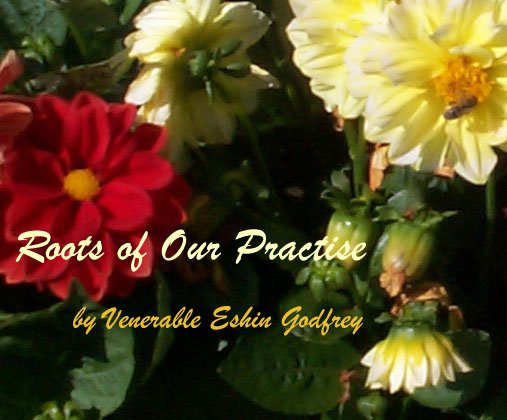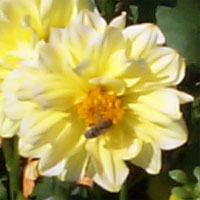

In Buddhism, there is an image of a true. A tree is actually used in many spiritual traditions. A tree and the parts of the tree represent spiritual practice, or spirituality. In terms of the tree, Buddhist practice is the leaves and the branches. And for someone who is very deeply radiant in their practice, this is also the fruit or the flowers of the tree. But it is also necessary to emphasise the roots of the tree. The roots are what we call 'awakening', or enlightenment. We need to understand that 'awakening' is not just the practice of becoming a better person. It is something more fundamental. In fact it is the roots of the tree that support the trunk, branches and flowers. They both go together to make a whole tree.
We all have a 'self', and so we study and investigate ourselves. In Zen, the initial tool we use for this investigation is awareness. This is not thinking about ourselves, but being aware of the activity of ourselves; being aware of our mind rather than just being swept up by the thoughts in our mind. If we have a good basis of awareness of how our mind functions then we can reflect on this. It can take some time, but with practice, the small self disappears on occasion. Traditionally this is called samadhi. Samadhi is not a mental state; it is none other than the true activity of the dharma. This is called our Buddha nature, our true self. It is not the self that is always thinking 'I am'. In Zen it is called 'no self'.
 In
order to come to awakening and enlightenment we need to allow our small self
to disappear at times. Losing the ego does not mean just being nice and passive
and doing what people want. This would simply be a passive form of the ego.
Rather we are talking about our small mind as simply letting go and disappearing
at times. And when it does, the natural clarity and brilliance of everything
appears.
In
order to come to awakening and enlightenment we need to allow our small self
to disappear at times. Losing the ego does not mean just being nice and passive
and doing what people want. This would simply be a passive form of the ego.
Rather we are talking about our small mind as simply letting go and disappearing
at times. And when it does, the natural clarity and brilliance of everything
appears.
If we consider it, the ego says, "I can't grasp it. How can I do it?" This is simply affirming the ego 'I am' self. To put down strong roots in this spiritual tree requires us to become so present in what we are doing that we become what we are doing and the small self disappears.
Even the great Zen masters of the past had to struggle sometimes for a long time to get their first true glimpse of enlightenment. Of course, in the meantime the practice of cultivating being a wholesome person is being done.
A tree can be wonderful in its appearance but if it lacks strong roots then there will be difficulty in the practice of becoming a wholesome person, particularly in difficult situations. When we put down roots and come to a real realization of awakening this affects us deeply to the marrow of our bones. To put down roots is to realize and actualize our true self; our Buddha nature. This is none other than the activity of wisdom; of realization. When we embody awakened wisdom, we naturally do not make errors.
In Buddhism there are the sila (which are often translated as precepts). For the conventional unenlightened self it might be helpful to have outside rules like 'don't steal, don't lie, don't become intoxicated', etc. These will certainly help us in society and as a person.
However, as our awakening deepens and our realization of the wisdom of our true self awakens, we come to live this more fully. This awakening self takes everything as its home. There is no stealing when we genuinely know everything is ourselves and that everything belongs to everyone. The 'spotless integrity' of treating everything in its correct way is equivalent to not stealing. When we have this awakened mind, there is a natural practice of keeping this awakened mind and not clouding it. This is the true meaning of not taking intoxicants; to not do things that cloud the innate purity of our mind. Awakened mind naturally does not make mistakes. It does the activity of maintaining awakened mind while interacting in the world. This is sila; it is pure not in the sense of good as opposed to bad, but good without qualifications.
As we awaken to Buddha Nature we find this is also to become the Dharma activity. How do we become this activity of the dharma? The fact is there is nothing other than the activity of the dharma. Every single thing and person in this great world is doing the activity of the dharma. It is true that the activity of the dharma sometimes stagnates and separates itself to form a sense of self-centered 'I am'. It is important to have an 'I am self' as it is this ego self that thinks about things and about the spiritual aspect of self. It is this 'I am self' that comes to the wisdom that it is limited and can develop.
 How
do we become this activity of the Dharma that in fact is simply always happening.
It is by fully becoming the activity of the dharma. For example, if we are talking
to friends, it is none other than the activity of awakening to totally talking
and listening. If we are not fully engaged in what we are doing, we find ourselves
in the self-centered 'I am' self, indulging the self. When we talk too much,
we are affirming the 'I am self'.
How
do we become this activity of the Dharma that in fact is simply always happening.
It is by fully becoming the activity of the dharma. For example, if we are talking
to friends, it is none other than the activity of awakening to totally talking
and listening. If we are not fully engaged in what we are doing, we find ourselves
in the self-centered 'I am' self, indulging the self. When we talk too much,
we are affirming the 'I am self'.
Whether we are speaking verbally to someone or simply chattering in our mind, this is becoming one-sided in the 'I am'. Talking and then fully listening to the other so fully that we are not separate from this activity is the activity of the dharma.
When we stand a little outside of the events of our life, we are coalescing into a small 'I am' self. When we manifest ourselves in our surroundings and allow our surroundings and the people in it to manifest themselves and thus interweave this movement between inside/outside, subject/object we are becoming the activity of the Dharma.
When we force things we are affirming 'I am' in a positive way. When we are not fully engaged, we are affirming 'I am' in a negative way. These are not true practice.
In our breath, it is simply allowing the inbreath to pull along the outbreath to its smallest point. As the inbreath completes itself it rests and the outbreath takes the initiative and completes itself in breathing out and at the same time pulls the inbreath to its smallest point.
The activity of the dharma is simply full engagement in what we are doing. It is full engagement to such a degree that we let go of the "I am" standpoint and become the activity of the moment. As we practice we discover that all along we have been undertaking the activity of dharma. We learn to stand a bit back from the activity, and catch it just as it is now and then. We discover this principle of the activity of the dharma moving between self and other, inside and outside, past and future. This is our true life; the practice of moving between living and dying. It is an awakening of our true self and putting down roots of our true self. This interaction between subject and object, self and other, past and future, brings about the wonderful branching and flowering of this tree.